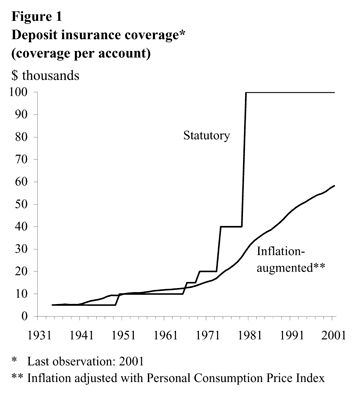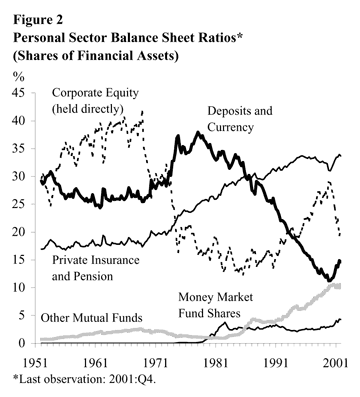When it comes to compromise, we can take comfort in the old saying, “half a loaf is better than none.” But when it comes to legislation on deposit insurance reform now before Congress, that old saying takes a new twist: “half a loaf is even better than a whole loaf.”
When it comes to compromise, we can take comfort in the old saying, “half a loaf is better than none.” But when it comes to legislation on deposit insurance reform now before Congress, that old saying takes a new twist: “half a loaf is even better than a whole loaf.” Why? Because while “half of the loaf” contains provisions that could contribute to better risk-based pricing of deposit insurance and better protection for the deposit insurance fund, the other half contains provisions that could exacerbate the moral hazard problem inherent in the deposit insurance system.
This Economic Letter reviews the major provisions of the legislation and explains which provisions belong to which half of the loaf, and why.
Reform bills—the half worth keeping
In mid-February, both houses of Congress introduced deposit insurance reform bills that were broadly similar and reflected many of the options included in a report by the Federal Deposit Insurance Corporation (FDIC 2001). But only a subset of the bills’ provisions deals with “reform” in the sense of reducing moral hazard or making the deposit insurance fund more secure. With deposit insurance, insured depositors have little or no incentive to monitor banks’ risk or to require higher interest rates from riskier banks. This can lead to a moral hazard problem because, without the feedback from a higher cost of funds, a bank may tend to invest in riskier assets. Part of bank regulators’ job is to keep the moral hazard problem in check using various regulations, including capital requirements, direct supervision, and, in the case of the FDIC, risk-based deposit insurance premiums.
One provision for reform is to merge the Bank Insurance Fund with the Savings Associations Insurance Fund. Combining the two funds could benefit the insurance system by pooling risk among a larger number of institutions. It also would solve the potential problem of different insurance premium payments for commercial banks and savings institutions; under the current arrangement, these differences would arise not from differences in risk exposure but from differences in the timing and amounts needed to recapitalize the two insurance funds.
Other provisions could help reform deposit insurance by facilitating risk-based pricing of deposit insurance, though the provisions do not deal with such pricing directly. Important elements of such provisions are replacing the fixed Designated Reserve Ratio (DRR) with a Reserve Range and granting the FDIC more flexibility in setting surcharges to recapitalize the insurance fund.
Currently the FDIC is directed to target reserve fund balances to equal 1.25% of insured deposits. The rules for hitting the DRR target have led to peculiar deposit insurance pricing. The current law requires that, if the insurance fund drops below the DRR target and cannot be replenished within one year, the FDIC must assess premiums across the board at a rate of at least 23 basis points, regardless of the riskiness of an individual institution. When the insurance fund is at or above the DRR target, pricing swings to the other extreme—insured institutions that are well-capitalized and have high supervisory ratings pay no insurance premiums. Currently, over 90% of insured institutions do not pay deposit insurance premiums. While such institutions may be sound, their probability of failure is not zero, so they pose some risk to the insurance fund and should not be assessed a zero premium.
In addressing these issues, the House measure that was recently approved by its Committee on Financial Services would replace the DRR target with a range of between 1.15% and 1.4% of insured deposits (1% and 1.5% in the Senate version). The FDIC Board would have some flexibility in determining the adequacy of balances within the range and the need to replenish the fund. Recapitalization of the insurance fund also could be more gradual since the reform would repeal the 23-basis-point minimum assessment rule. This would limit the swings in insurance premiums that are unrelated to the riskiness of institutions. The reform also would eliminate free deposit insurance, which would give the FDIC more flexibility to charge premiums for deposit insurance coverage that are linked to risk.
Of course, even with these changes, at times banks still would get rebates (or credits) when the reserves in the deposit insurance fund approach or reach the 1.4% (or 1.5%) upper bound of the range. As a practical matter, such rebates would reduce the net cost of insurance. However, under the reform packages, the rebates likely would be based on past levels of deposits and would be independent of a current year’s premiums paid. This means that an institution still could be assessed a premium reflective of its risk even when the insurance fund is highly capitalized, again allowing the FDIC to tie premiums more closely to individual banks’ risk if the agency opts to do so. The structure of the rebates (and other provisions of the House bill) also would limit the so-called free-rider problem in which new or rapidly growing depository institutions do not have to pay insurance premiums on their new deposits when the fund is at or above the DRR.
The other main provisions of the legislation would raise the level of insurance coverage. While the specifics might change, at this point the proposals would increase the basic coverage by $30,000. Moreover, retirement accounts—including IRA, Keogh, and 401(k) plans—would receive two times the amount of the new standard deposit insurance coverage limit, i.e., $260,000 according to the House bill, and $250,000 according to the Senate version. Both bills would raise coverage of in-state municipal deposits to 80% of balances over $130,000 up to an aggregate level of $5 million. In addition, the proposals call for indexing the levels of insurance coverage to the rate of inflation. These changes clearly are not directed at reforming deposit insurance in terms of protecting the insurance fund or reducing the moral hazard problem. In fact, increasing coverage would tend to have the opposite effect.

What are they designed to achieve, then? One rationale is that, to ensure equity for savers or financial stability, the nominal level of insurance coverage should increase over time to keep the real value of insurance coverage relatively stable. In 1934, deposit insurance coverage was set at $5,000. As Figure 1 shows, for about the next 40 years, up to the early 1970s, the statutory (or actual) level of coverage moved roughly in line with how much the coverage needed to rise to reflect inflation rates; that is, the two lines are relatively close during that period because the statutory changes in coverage just kept up with inflation.
The pattern changed somewhat in 1974, when coverage rose from $20,000 to $40,000, boosting it above the level required to account for inflation. The pattern changed dramatically in 1980, when coverage rose to $100,000. That change pushed the statutory coverage $70,000 above the level required to compensate for inflation. As of 2001, the gap was still $42,000. In fact, at an inflation rate of 3% per year, it would take until 2020 for the two lines to cross; that is, in terms of augmenting the insurance coverage for inflation, the current limits could suffice for almost two more decades.
Other rationales for raising deposit insurance limits focus on the need to offset certain competitive imbalances. For example, some claim that community banks are at a disadvantage relative to very large banks that might be seen as “too big to fail.” Some also claim that the $100,000 limit on coverage curtails small banks’ ability to service local governmental agencies, whose deposits are typically much higher. In addition, some argue that the current limit handicaps banks generally in attracting retirement savings, such as 401(k) accounts, because a saver with balances over the insurance limit will opt for a nonbank investment outlet. These points, however, are debatable. For example, in terms of attracting retirement savings, with financial deregulation, banks can offer non-deposit options to savers. And in general, it is not clear that increasing deposit insurance coverage is the appropriate vehicle for addressing competitive issues among financial institutions.
More importantly, there does not appear to be a strong case for raising insurance coverage further or for indexing current coverage limits to the inflation rate in the near-to-intermediate horizon on the grounds that doing so would protect savers or ensure financial stability, which after all should be the underlying goals of deposit insurance. For lower income households that rely relatively more on deposit accounts, deposit insurance coverage has more than kept up with inflation. Furthermore, with the progress in financial modernization, savers with even modest levels of financial assets have more opportunities today to diversify. The 1998 Federal Reserve’s Survey of Consumer Finance indicates that, among families with incomes between $25,000 and $100,000, about the same percentage had mutual fund accounts as had time deposit accounts. In addition, the median dollar amount was a bit higher for the mutual fund accounts than for the time deposit accounts. For example, among households with incomes between $25,000 and $50,000, the median value of holdings in mutual funds was $13,800 compared to $10,600 in time deposit accounts.

Moreover, households and small businesses in general are relying less on deposit accounts. Figure 2 plots the ratios of selected financial assets to total financial assets for the personal sector, which includes households, nonfarm-noncorporate businesses, and farms. After rising some in the 1970s, the deposit share of financial assets has declined and is below the ratios that prevailed even in the 1950s and 1960s. The savings vehicles for which the shares have risen the most are pension funds and mutual funds, including money market funds, which are highly liquid.
The provisions of the deposit insurance reform legislation that would give the FDIC more flexibility in setting deposit insurance premiums are positive, if measured, steps toward reform. Merging the deposit insurance funds also would be a positive move for the FDIC’s risk management. These represent the half a loaf worth pursuing. However, given the underlying purposes of deposit insurance, there does not appear to be a strong case for raising insurance coverage further or for indexing the current limits to the inflation rate in the near-to-intermediate horizon—leave that half of the loaf for the future.
Fred Furlong
Vice President
Financial and Regional Research
Simon Kwan
Research Advisor
Reference
Federal Deposit Insurance Corporation. 2001. Keeping the Promise: Recommendations for Deposit Insurance Reform (April).
Opinions expressed in FRBSF Economic Letter do not necessarily reflect the views of the management of the Federal Reserve Bank of San Francisco or of the Board of Governors of the Federal Reserve System. This publication is edited by Anita Todd and Karen Barnes. Permission to reprint portions of articles or whole articles must be obtained in writing. Please send editorial comments and requests for reprint permission to research.library@sf.frb.org